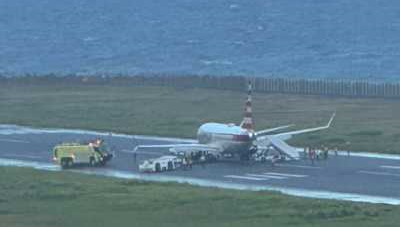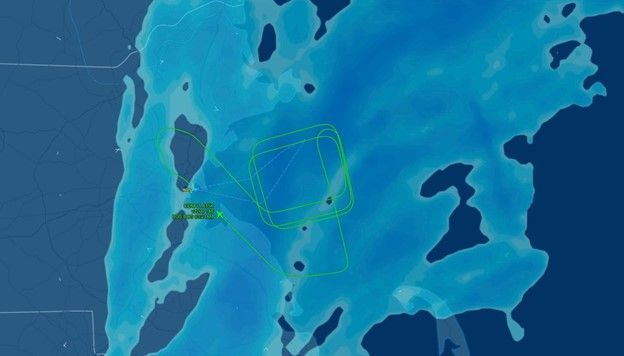ARFF Daily News
Published on:
Tuesday the 21st of January, 2025
Loud explosion heard after American Airlines plane lands at SVG airport
Guardian Media Newsroom
Firefighters at the Argyle International Airport in St Vincent were responding to an incident involving an American Airlines aircraft soon after it landed there on Monday afternoon.
The exact nature of the incident is not clear at this time, but eyewitnesses told the Caribbean Media Corporation (CMC) that at 4:46 pm (local time), they had “just heard a big explosion” from an aircraft that just landed at the Argyle Airport.
“Fire trucks from the airport just went to assist,” one eyewitness said, adding that smoke had been seen coming from the landing gear of the aircraft before it went out of sight.
Images from a Facebook live video by Travis Harry around 5:10 pm (local time), showed the aircraft near the eastern end of the runway.
Passengers from the aircraft were deplaning via stairs and were being boarded on minibuses, presumably for transportation to the terminal. Fire trucks also were seen near the aircraft as this was taking place.
Authorities are yet to comment on the incident.
This is the first major incident at the airport, which was opened on February 14, 2017. —KINGSTOWN, St. Vincent (CMC)
https://www.cnc3.co.tt/loud-explosion-heard-after-american-airlines-plane-lands-at-svg-airport/

Cathay Pacific flight forced to return to Boston as smoke fills cabin just 30 minutes after takeoff
By Patrick Reilly
A Cathay Pacific flight from Boston was forced to make a U-turn early Monday as smoke filled the cabin just 30 minutes after takeoff, the airline said.
The pilot of flight CX811 called through a mayday soon after taking off from Logan International Airport for Hong Kong around 2:30 a.m., records show.
The emergency was called because smoke was seen filling the cabin, a Cathay Pacific spokesperson confirmed to The Post.
The plane circled over Massachusetts Bay before returning and landing safely to the airport, data on FlightAware shows.
“No injuries among our customers or crew were reported,” the spokesperson said.
Engineers are inspecting the plane at the gate to see what caused the smoke, the rep said.
“We have been regularly informing our customers of the latest status of the flight and will continue to provide them with appropriate assistance,” the spokesperson said.
https://nypost.com/2025/01/20/world-news/flight-forced-back-to-boston-as-smoke-fills-cabin/

NTSB Final Report: Radley Vincent Quicksilver Sport 2S
As It Climbed In A Left Turn It Encountered An Aerodynamic Stall, Spun To The Left, And Impacted The Ground
Location: Cleveland, Georgia Accident Number: ERA24FA221
Date & Time: May 20, 2024, 08:42 Local Registration: N960B
Aircraft: Radley Vincent Quicksilver Sport 2S Aircraft Damage: Substantial
Defining Event: Loss of control in flight Injuries: 1 Fatal
Flight Conducted Under: Part 91: General aviation - Flight test
Analysis: The owner of the experimental amateur-built airplane transported it via ground to the sport pilot/light sport aircraft repairman’s facility at a grass airstrip, so that an annual condition inspection could be completed. Although the sport pilot/repairman had performed maintenance work on the airplane make and model, he had never flown one. After the sport pilot completed the inspection, he attempted a post-maintenance flight. Airport security video revealed that immediately after liftoff, the airplane turned left about 90°. The engine noise decreased, and the airplane appeared to momentarily come under control; however, it was flying toward the front of a hangar. The engine nose increased again, and the airplane cleared the hangar, but as it climbed in a left turn it encountered an aerodynamic stall, spun to the left, and impacted the ground. Postaccident examination of the wreckage revealed no evidence of any preimpact mechanical malfunctions of the airframe or engine.
The airplane owner described that due to the short tail, the airplane lacked rudder effectiveness at slow airspeeds and was subject to left turning tendencies (p-factor). After viewing the video, the airplane owner further stated that it appeared the sport pilot rotated too early and over-rotated, resulting in the loss of control to the left.
Probable Cause and Findings: The National Transportation Safety Board determines the probable cause(s) of this accident to be -- The pilot’s failure to maintain control of the airplane during the takeoff and his exceedance of the airplane’s critical angle of attack, which resulted in an aerodynamic stall and spin at low altitude. Contributing to the accident was the pilot’s lack of experience in the accident airplane make and model.
FMI: www.ntsb.gov

Today in History
40 Years ago today: On 21 January 1985 Galaxy Airlines flight 203, a Lockheed L-188 Electra, crashed shortly after takeoff from Reno/Tahoe Airport, NV, USA, killing 70 occupants; 1 survived the accident.
Date: Monday 21 January 1985
Time: 01:04
Type: Lockheed L-188A Electra
Owner/operator: Galaxy Airlines
Registration: N5532
MSN: 1121
Year of manufacture: 1960
Total airframe hrs: 34148 hours
Cycles: 33285 flights
Engine model: Allison 501-D13
Fatalities: Fatalities: 70 / Occupants: 71
Other fatalities: 0
Aircraft damage: Destroyed, written off
Category: Accident
Location: 3 km SE of Reno/Tahoe International Airport, NV (RNO) - United States of America
Phase: Initial climb
Nature: Passenger - Non-Scheduled/charter/Air Taxi
Departure airport: Reno/Tahoe International Airport, NV (RNO/KRNO)
Destination airport: Minneapolis-St. Paul International Airport, MN (MSP/KMSP)
Investigating agency: NTSB
Confidence Rating: Accident investigation report completed and information captured
Narrative:
Galaxy Airlines flight 203, a Lockheed L-188 Electra, crashed shortly after takeoff from Reno/Tahoe Airport, NV, USA, killing 70 occupants; 1 survived the accident.
Galaxy Airlines Lockheed L-188A Electra, registration N5532, was scheduled operate flights from Seattle (SEA) to Oakland as Flight 201, from Oakland to Reno (RNO) as Flight 202, from Reno (RNO) to Minneapolis (MSP) as Flight 203 and finally returning to Seattle using flight number 204.
Scheduled departure time for Flight 201 had been 15:30, but had been delayed and the airplane departed Seattle at 20:19 on a ferry flight to Oakland, where it arrived at 22:25. Sixty-five passengers boarded the plane for the flight to Reno. Following ground servicing the ground handler supervisor signalled to the crew that they could commence engine starting. However, after engines one and four were started, he noticed that the other ground handler was unable to disconnect the air start hose. It was stretched taut from the power cart to the airplanes air start access panel, located on the underside of the right wing leading edge, close to the fillet area. The supervisor gave the flightcrew an emergency stop signal, left his position, and disconnected the hose. None of the two ground crewmembers remembered closing the air start access door.
At approximately 00:59 the first officer requested taxi instructions Reno tower almost immediately thereafter cleared Galaxy 203 to taxi to runway 16R. The aircraft taxied to the runway and at 01:01:32 the first officer requested takeoff clearance. Four seconds later Galaxy 203 was given clearance to take off from runway 16R. While accellerating through V1 speed, a "thunking" type sound was heard, followed by another one just after V2. Heavy airframe vibration started after liftoff. The captain reacted to the airplanes vibration by reducing power significantly in all four engines, indicating that he believed the vibration was caused by the powerplants or propellers. The airplane reached an altitude of about 200-250 feet and started a right hand turn to return to the airport. The Electra then entered an aerodynamic stall buffet because of insufficient engine power to maintain flight. The Electra crashed into a field, bounced, slid into some mobile homes and burst into flames.
Of the 71 occupants, three initially survived the crash. One died on January 29, while the second died of injuries on February 4. The sole survivor, a 17-year-old male, was thrown clear of the airplane onto the adjacent highway.
PROBABLE CAUSE: "The captain's failure to control and the co-pilot's failure to monitor the flight path and airspeed of the aircraft. This breakdown in crew coordination followed the onset of unexpected vibration shortly after takeoff. Contributing to the accident was the failure of ground handlers to properly close an air start access door, which led to the vibration."

Mailing Address
Subscribe to our newsletter
Contact Us
We will get back to you as soon as possible.
Please try again later.
